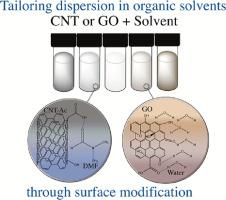Surfaces and Interfaces ( IF 5.7 ) Pub Date : 2021-04-08 , DOI: 10.1016/j.surfin.2021.101121 Thais C. de Oliveira , Filipe V. Ferreira , Beatriz R.C. de Menezes , Diego M. da Silva , Alan S. dos Santos , Elizabete Y. Kawachi , Evelyn A.N. Simonetti , Luciana S. Cividanes

|
The surface modification of carbon-based nanomaterials, including carbon nanotubes (CNTs) and graphene oxide (GO), is advantageous for tailoring their dispersion in different solvents, as well as polymer matrices. Although the surface modification methodology of such nanomaterials is well established, the relationship between functionalization and interaction with the surrounding environment (solvents or polymers) – particularly repulsion/attraction forces that govern the clusters’ formation – is still not well understood to date. Herein, the dispersion of pristine and oxygenated/amino-functionalized CNTs and GO in different solvents were studied qualitatively (by optical microscopy and visual observations of dispersion tests) and quantitatively (by UV–Vis spectroscopy), and the repulsion/attraction process was explained based on π-π* transitions between CNT or GO and solvents. We found that both CNT and GO can have good dispersion in water, N-methyl-2-pyrrolidone (NMP), and N,N-dimethylformamide (DMF), and the key to this behavior is the precise functionalization control, including orientation and type of functional group. In this sense, the introduction of functional groups improves the interaction quality of CNT and GO due to nanoscale attraction, and at the same time, enhances their orientation due to steric effect. The present study is expected to contribute to carbon-based nanomaterials’ surface engineering, which may be useful for researchers from different fields, such as carbon nanostructures, materials chemistry, and polymer nanocomposites.
中文翻译:

工程碳基纳米材料的表面,以控制在有机溶剂或聚合物基质中的分散性
包括碳纳米管(CNT)和氧化石墨烯(GO)在内的碳基纳米材料的表面改性有利于调整它们在不同溶剂以及聚合物基质中的分散性。尽管此类纳米材料的表面改性方法学已广为人知,但迄今为止,功能化与与周围环境(溶剂或聚合物)之间的相互作用(尤其是控制团簇形成的排斥力/吸引力)之间的关系仍然知之甚少。在此,定性研究了原始和含氧/氨基官能化的CNTs和GO在不同溶剂中的分散性(通过光学显微镜和分散试验的目测观察),并定量研究了(通过UV-Vis光谱法),并基于CNT或GO与溶剂之间的π-π*跃迁解释了排斥/吸引过程。我们发现CNT和GO在水,N-甲基-2-吡咯烷酮(NMP)和N,N-二甲基甲酰胺(DMF)中均具有良好的分散性,而此行为的关键是精确的官能化控制,包括取向和功能组的类型。从这个意义上说,引入官能团可提高纳米尺度吸引力,从而提高CNT与GO的相互作用质量,同时由于空间效应而提高其取向性。预期本研究将有助于碳基纳米材料的表面工程,这可能对来自不同领域的研究人员有用,例如碳纳米结构,材料化学和聚合物纳米复合材料。我们发现CNT和GO在水,N-甲基-2-吡咯烷酮(NMP)和N,N-二甲基甲酰胺(DMF)中均具有良好的分散性,而此行为的关键是精确的官能化控制,包括取向和功能组的类型。从这个意义上说,引入官能团可提高纳米尺度吸引力,从而提高CNT与GO的相互作用质量,同时由于空间效应而提高其取向性。预期本研究将有助于碳基纳米材料的表面工程,这可能对来自不同领域的研究人员有用,例如碳纳米结构,材料化学和聚合物纳米复合材料。我们发现CNT和GO均可在水中,N-甲基-2-吡咯烷酮(NMP)和N,N-二甲基甲酰胺(DMF)中具有良好的分散性,而这种行为的关键是精确的官能化控制,包括取向和功能组的类型。从这个意义上说,引入官能团可提高纳米尺度吸引力,从而提高CNT与GO的相互作用质量,同时由于空间效应而提高其取向性。预期本研究将有助于碳基纳米材料的表面工程,这可能对来自不同领域的研究人员有用,例如碳纳米结构,材料化学和聚合物纳米复合材料。包括功能组的定位和类型。从这个意义上说,引入官能团可提高纳米尺度吸引力,从而提高CNT与GO的相互作用质量,同时由于空间效应而提高其取向性。预期本研究将有助于碳基纳米材料的表面工程,这可能对来自不同领域的研究人员有用,例如碳纳米结构,材料化学和聚合物纳米复合材料。包括功能组的定位和类型。从这个意义上讲,引入官能团可提高纳米尺度吸引力,从而提高CNT与GO的相互作用质量,同时由于空间效应而增强其取向。预期本研究将有助于碳基纳米材料的表面工程,这可能对来自不同领域的研究人员有用,例如碳纳米结构,材料化学和聚合物纳米复合材料。











































 京公网安备 11010802027423号
京公网安备 11010802027423号